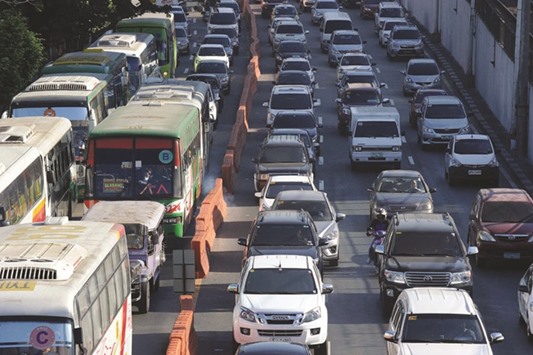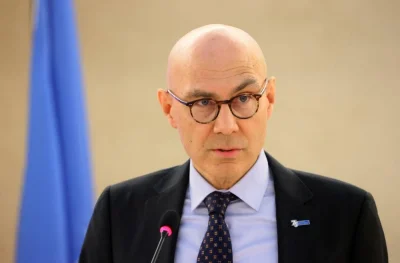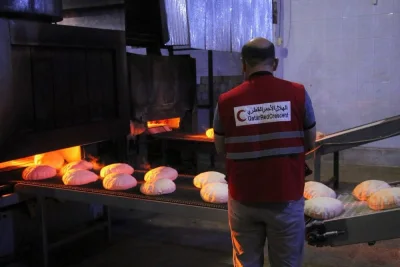
A major thoroughfare is clogged with traffic in Manila. Right: Maria Zurbano (right) travels in a van to work in suburban Manila.
Former Interior Secretary Manuel “Mar” Roxas, apparently with the help of the Liberal Party (LP) through Secretaries Florencio Abad of the Department of Budget and Management (DBM) and Mel Sarmiento of the Department of the Interior and Local Government (DILG), promised P100mn worth of projects for each mayor who will support his candidacy in the May 2016 presidential elections, according to a highly-placed source.
The promise was made when Roxas, standard-bearer of the ruling party, met with members of the League of Municipalities of the Philippines (LMP) National Executive Committee (NEC) at the Resorts World Hotel in Pasay City (Metro Manila) in December last year.
The source, who listened in on the meeting, told Manila Times that the millions worth of projects will be funded under the Bottom Up Budgeting (BuB) programme.
“It was a day-long activity that happened one Thursday in the first week of December. They (LMP National Executive Committee officials) had a breakfast meeting with Secretary Sarmiento. In the afternoon, Roxas was there and he practically promised the mayors P100mn for each of their municipalities beginning this year,” he said.
The purported meeting was held at the hotel’s Passion Restaurant.
After Roxas spoke, a female undersecretary of the DBM gave a 30-minute briefing on the BuB.
The LMP National Executive Committee is led by Javier town mayor Sandy Javier. It has 22 members as shown on its website.
“Roxas told them that the priority this year is for mayors to have projects. Javier told them not to waste this opportunity. Reading between the lines, Roxas was telling the NEC members that if he wins, the P100mn is good to go until 2022,” said the source, who was once an official of a top government agency.
He added that when Roxas left and after the DBM briefing, the mayors continued to discuss what was promised to them.
“Many of them were adamant and doubtful. They said they have no assurance that the P100mn could be delivered in exchange for supporting Roxas’ candidacy,” the source said.
Javier ended the discussion by deferring the matter until they reach Macau for a weekend holiday.
“That was when I realised that the NEC officials were in Manila because of a scheduled trip to Macau. Roxas’ presence on the eve of their trip certainly raised eyebrows. Who spent for them? Your guess is as good as mine,” the source told Manila Times.
Only recently, Cabinet officials led by Sarmiento were in Nueva Ecija for their campaign leg on the BuB.
There, they discussed how local government units (LGUs) can avail of the programme.
In April 2015, the LMP passed a resolution in “support for and encouragement of the leadership and governance” of Roxas, whom they described as “a man of honour, integrity and unsullied reputation whose character is above suspicion” and a “visionary, selfless, competent, motivational” leader.
The DBM has five female undersecretaries and five female assistant secretaries.
The Manila Times inquired with Budget Policy and Strategy Undersecretary Laura Pascua if she was the official who gave the league officials the briefing at Passion Restaurant.
“Unfortunately, I am not the one you need. I’m furnishing our PIU (Public Information Unit) head Peachy Paderna a copy of this note so you can contact them. Thanks,” Pascua told this paper. The DBM public information chief, however, failed to send a statement as of press time yesterday.
BuB is widely perceived as a revived “pork barrel” fund intended for LGUs since the Supreme Court ruled previous development assistance funds as unconstitutional.
Originally known as “Grassroots Participatory Budgeting” in deliberations for the 2015 budget, the DBM chief decided to use the BuB name in October 2014.
Former Ambassador and Manila Times columnist Rigoberto Tiglao, in one of his previous articles, claimed that “the term BuB portrays it as a democratic exercise, when in fact, it is designed entirely to disguise the pork barrel scheme carried on last year and is set to continue this year.”
“Even the figure for this year, P20.9bn, is equivalent to the pork barrel funds of P16bn each for 2011 and 2012, and P20bn in 2014, adjusted for inflation
One of the Supreme Court’s definitions of pork barrel, when it ruled it unconstitutional, is as follows: “An appropriation of government spending meant for localised projects and secured solely or primarily to bring money to a representative’s district,” he said.
Tiglao further alleged that President Benigno Aquino and Abad “revised certain aspects of its use in order to skirt certain guidelines issued by the court.”
The DBM chief has boasted that the BuB has been recognised by the Global Initiative for Fiscal Transparency (GIFT) as one of five Best Practices in Fiscal Transparency from around the world during the Open Government Partnership (OGP) summit in
Mexico City.
Roxas: dangling projects
Big dreams but little action for Manila’s traffic nightmare
AFP/Manila
Web designer Maria Zurbano kisses her three-year-old daughter goodbye and sets out in the pre-dawn darkness for a torturous commute through the Philippine capital.
Her ordeal, a return trip of up to six hours every weekday, is expected to get even worse as the number of cars explodes in the chaotic Asian mega-city of more than 12mn people.
Dubbed “carmaggedon” by locals, business leaders are warning Manila could come to a total standstill despite grand government plans to tackle its traffic.
“Physically, during these trips, I feel ill. My back is always hurting. It affects my health to have to sit down for so long,” said Zurbano, 36, as she waited for a bus outside her home at 5:00 am.
After finally ending a cramped mini-bus trip of just 17 kilometres to the financial district of Makati, Zurbano despaired of being trapped in a traffic hell.
“Traffic just gets worse and worse. I just get more stressed and stressed but it doesn’t look like anything will change. I will just have to learn to bear with it,” she said.
Traffic in the capital and its surroundings is already costing the country about 3bn pesos ($64mn) a day, or about 0.8% of gross domestic product, according to government figures.
And it is steadily worsening as an emerging middle class fuels an auto boom — car sales rose 23% last year with nearly 300,000 new vehicles hitting the roads.
Compounding the problem, decades of infrastructure neglect has left Manila with a just a few major roads across the city and their gridlock “peak hours” often last for three or four hours.
Commuters have few other options with Manila’s dilapidated rail network tiny in comparison with neighbouring Southeast Asian capitals such as Jakarta, Kuala Lumpur and Bangkok.
A chaotic private bus and mini-bus network with drivers who regularly flout traffic laws by, for instance, stopping in the middle of roads to pick up passengers, is widely perceived as adding to the problem.
“This is going to be the most critical problem the next administration faces,” said John Forbes, a senior adviser at the American Chamber of Commerce in Manila.
Forbes warned Manila risked becoming “uninhabitable” in the next three to five years — meaning people would simply be unable to get around the city — if urgent action was not taken to build roads and rail lines.
Elections for a successor to President Benigno Aquino, who is required by the constitution to stand down after a single six-year term, will be held in May.
Aquino has proved a generally popular president but he has been the target of fierce public criticism for a perceived lack of urgency in updating the nation’s creaking infrastructure.
He earnt widespread condemnation mid-way through his term with comments that worsening traffic was merely a sign of a growing economy.
His aides have since sought to project a sense of empathy and urgency, pointing to new expressways and an extension of a train line as planned projects that will ease the congestion. They have also emphasised the adoption in 2014 of a “Dream Plan” to fix the urban chaos, which outlines $65bn of infrastructure spending by 2030.
The plan envisages a wide range of massive and unprecedented projects for the Philippines, such as a subway, satellite cities linked to Manila by high-speed rail, relocating air and sea ports, as well as many new roads.
Finance Undersecretary Gil Beltran, an economist who has studied the traffic problem, said the plan’s huge price tag is within the government’s reach.
“Financing should not be a problem because the funders are ready,” Beltran said, pointing to the nation’s improved credit rating that will allow cheaper loans, as well as expected help from the Japanese government and multilateral lenders. But many experts believe there is little chance of many projects going ahead.
They point to the nation’s chaotic and corrupt democratic system, as well as a strangling bureaucracy, which prevent infrastructure development.
A glaring example is the construction of a 19-kilometre light rail line on the outskirts of the capital that was meant to have been finished by the end of last year — but it has not even been started.
Touting the project in 2013, Aquino joked he was ready to be run over a train if it was not completed by the end of 2015. But his government has not even finalised the tender process.
Gilbert Llano, president of the Philippine Institute for Development Studies, a government think-tank, echoed the ironic tones of many experts when talking about the government’s infrastructure plan.
“It’s called a dream plan (because) it will stay in the realm of dreams,” said Llanto.


